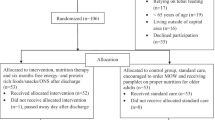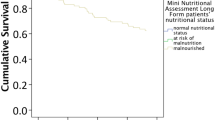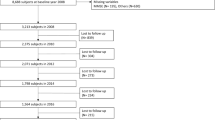Abstract
Objective: To investigate nutritional status and its relationship to cognition, well-being, functional ability and energy intake in frail elderly service flat residents.
Design: Cross-sectional and prospective study.
Setting: Two municipal service flat complexes.
Subjects: A total of 80 residents (median age 85.5 (79–90) y) with regular home care assistance participated. A subgroup of 35 residents took part in a re-examination 1 y later.
Methods: Mini Nutritional Assessment (MNA), Short Portable Mental Status Questionnaire, Barthel Index and Health Index were used for the evaluation of nutritional, cognitive and ADL function and well-being, respectively.
Results: In all, 30% of the frail and chronically ill service flat residents were assessed as malnourished and 59% were at risk of malnutrition. The malnourished residents had worse cognitive conditions (P<0.001) and well-being (P<0.05), lower functional ability (P<0.01) and they had a greater need for daily assistance (P<0.05) than the other residents. The median night fast period was 14.0 (12.5–15.0) h. Five subjects classified as malnourished at baseline had lost a median of −9.6 kg (range −11.0 to +7.3 kg) (P<0.05) in body weight at the 1-y follow-up, which contrasted significantly from the weight stability in residents classified as at risk for malnutrition or well-nourished.
Conclusion: Out of 10 residents, nine were assessed to have impending nutritional problems that related to impaired well-being, cognition, and functional ability. Malnourished residents had a significant weight loss over one year. Studies are needed to determine whether weight loss and nutrition-related dysfunction in service flat residents are preventable or treatable.
Sponsorship: Karolinska Institutet, Vårdal Foundation and the Swedish Medical Research Council.
This is a preview of subscription content, access via your institution
Access options
Subscribe to this journal
Receive 12 print issues and online access
$259.00 per year
only $21.58 per issue
Buy this article
- Purchase on Springer Link
- Instant access to full article PDF
Prices may be subject to local taxes which are calculated during checkout
Similar content being viewed by others
References
Beck AM & Ovesen L (1998): At which body mass index and degree of weight loss should hospitalized elderly patients be considered at nutritional risk. Clin. Nutr. 17, 195–198.
Bingham SA (1987): The dietary assessment of individuals; methods, accuracy, new techniques and recommendations. Nutr. Abstr. Rev. 57, 705–742.
Björkelund C, Hultén B, Larsson B, Lissner L, Rothenberg E, Bengtsson C, Steen B & Tibblin G (1997): New weight-height standards for middle-aged and elderly. Weight increases more than height. Läkartidningen 94, 332–335. (in Swedish).
Bonnefoy M, Conru C, Normand S, Boutitie F, Bugnard F, Rahmani A, Lacour JR & Laville M (2003): The effects of exercise and protein-energy supplements on body composition and muscle function in frail elderly individuals: a long-term controlled randomised study. Br. J. Nutr. 89, 731–738.
Bourdel-Marchasson I, Joseph PA, Dehail P, Biram M, Faux P, Rainfray M, Emerican JP, Canioni P & Thiaudière E (2001): Functional and metabolic early changes in calf muscle occurring during nutritional repletion in malnourished elderly patients. Am J. Clin. Nutr. 73, 832–838.
Bowling A (1997): Measuring Disease: A Review of Disease Specific Quality of Life Measurements Scales pp 182–185. Suffolk: St Edumndsbury Press.
de Castro JM, Brewer EM, Elmore DK & Orazco S (1990): Social facilitation of the spontaneous meal size of human occurs regardless of time, place, alcohol or snacks. Appetite 15, 89–101.
Cederholm T, Jägrén C & Hellström K (1995): Outcome of protein-energy malnutrition in elderly medical patients. Am. J. Med. 98, 67–74.
Chandra RK (1993): Nutrition and the immune system. Proc. Nutr. Soc. 52, 77–84.
Christensson L, Unosson M & Ek A-C (2002): Evaluation of nutritional assessment techniques in elderly people newly admitted to municipal care. Eur. J. Clin. Nutr. 56, 810–818.
Christensson L, Unosson M & Ek A-C (2003): Measurement of perceived health problems as a means of detecting elderly people at risk of malnutrition. J. Nutr. Health Aging 4, 257–262.
Colin C, Wade DT, Davies S & Horne V (1988): The Barhtel ADL index. A reliability study. Int. Disabil. Stud. 10, 61–63.
Covinsky KE, Martin GE, Beyh RJ, Justice AC, Sehgal AR & Landefeld CS (1999): The relationship between clinical assessments of nutritional status and adverse outcomes in older hospitalised medical patients. J. Am. Geriatr. Soc. 47, S32–S38.
Dey DK, Rothenberg E, Sundh V, Bosaeus I & Steen B (1999): Height and body weight in the elderly. A 25-year longitudinal study of a population aged 70 to 95 years. Eur. J. Clin. Nutr. 53, 905–914.
Ek AC, Unosson M, Larsson J, Von Schenk H & Bjurulf P (1991): The development and healing of pressure sores related to the nutritional state. Clin. Nutr. 10, 245–250.
FAO/WHO/UNU (1985): Report of a Joint Expert Consultation: Energy and Nutrient Requirements Technical Report Series 724, WHO, Geneva.
Flodin L, Svensson S & Cederholm T (2000): Body mass index as a predictor of 1 year mortality in geriatric patients. Clin. Nutr. 19, 121–125.
Forsberg C & Björvell H (1993): Swedish population norms for the GHRI, HI and STAI state. Qual. Life Res. 2, 349–356.
Gibson R (1990): Principles of Nutritional Assessment pp 37–39, Oxford University Press.
Goldberg GR & Black AE (1998): Assessment of the validity of reported energy intake—review and recent developments. Scand. J. Nutr. 1, 6–9.
Greenwood CE (2003): Dietary, carbohydrate, glucose regulation and cognitive performance in elderly persons. Nutr. Rev. 61, S68–S74.
Grundman M, Corey-Bloom J, Jernigan T, Archibald S & Thal LJ (1996): Low body weight in Alzheimeŕs disease is associated with mesial temporal cortex atrophy. Neurology 46, 1585–1591.
Guigoz Y, Vellas B & Garry PJ (1996): Assessing the nutritional status of the elderly. The Mini Nutritional Assessment as part of the geriatric evaluation. Nutr. Rev. 54 (Suppl), S59–S65.
Guigoz Y, Vellas B & Garry PJ (1997): Nutritional Assessment as part of the geriatric evaluation: The Mini Nutritional Assessment. In Nutrition in the Elderly. The Mini Nutritional Assessment (MNA). Facts and Research in Geriatrics eds. BJ Vellas, Y Guigoz, PJ Garry & JL Albarede, 4th Edition, pp 15–61. Paris, France: Serdi Publishing Company.
Hambraeus L (1998): Dietary assessments: how to validate primary data before conclusions can be drawn. Scand. J. Nutr. 42, 66–68.
Karlsson P, Apelgren J, Brismar K, Karlström B, Lindblad L & Cederholm T (1999): Nutritional status and food intake in a 1-year follow-up in a group of elderly residents in adapted housing. Scand. J. Nutr. 2, 70–73.
Kondrup J, Johamsen N, Plum LM, Bak L, Hojdlund Larsen J, Martinsen A, Andersen JR, Baernthsen H & Bunch E (2002): Incidence of nutritional risk and causes of inadequate nutritional care in hospitals. Clin. Nutr. 21, 461–468.
Landi F, Zuccalà G, Gambassi G, Incalzi RA, Manigrasso L, Pagano F, Carbonin P & Bernabei R (1999): Body mass index and mortality among older people living in the community. J. Am. Geriatr. Soc. 47, 1072–1076.
Larsson J, Unosson M, Ek AC, Nilsson L & Thorslund L (1990): Effect of dietary supplementation on nutritional status and clinical outcome in 501 geriatric patients—a randomised study. Clin. Nutr. 9, 179–184.
Lührmann PM, Herbert BM & Neuhäuser-Berthold M (2001): Underreporting of energy intake in an elderly German population. Nutrition 11/12, 912–916.
Mahoney FI & Barthel DW (1965): Functional evaluation: the Barthel index. Mary State Med. J. 14, 61–65.
McCormack P (1997): Undernutrition in the elderly population living at home in the community: a review of literature. J. Adv. Nurs. 26, 856–863.
Nes M, Van Staveren WA, Zajkas G, Inelman EM & Moreiras-Varela O (1991): Validity of the dietary history method in elderly subjects. Eur. J. Clin. Nutr. 45 (Suppl 3), 97–104.
Nordic Council of Ministers (1996): Nordic Nutrition Recommendations. 28 Copenhagen: Nordic Council of Ministers.
Nordström G, Nyman GR & Theorell T (1992): Psychosocial adjustment and general health in patients with ileal conduit urinary diversion. Scand. J. Urol. Nephrol. 26, 139–147.
Ödlund Olin A, Armyr I, Soop M, Jerström S, Classon I, Cederholm T, Ljunggren G & Ljungqvist O (2003): Energy-dense meals improve energy intake in elderly residents in a nursing home. Clin. Nutr. 22, 125–131.
Oh S-Y & Hong MH (1999): Within- and between-person variation of nutrient intakes of older people in Korea. Eur. J. Clin. Nutr. 53, 629–652.
Persson M, Brismar KE, Katzarski K, Nordenström J & Cederholm TE (2002): Nutritional status using Mini Nutritional Assessment and Subjective Global Assessment predict mortality in geriatric patients. J. Am. Geriatr. Soc. 50, 1996–2002.
Pfeiffer EA (1975): A short portable mental state questionnaire for the assessment of organic brain deficit in elderly patients. J. Am. Geriatr. Soc. 23, 433–441.
Poehlman ET & Dvorak RV (2000): Energy expenditure, energy intake and weight loss in Alzheimers disease. Am. J. Clin. Nutr. 71 (Suppl), S650–S655.
Potter JM, Roberts MA, McColl J & Reilly JJ (2001): Protein energy supplements in unwell elderly patients—a randomized controlled trial. J. Parent. Enteral Nutr. 25, 323–329.
Romagnoni F, Zuliani G, Bollini C, Leoci V, Soattin L, Dotto S, Rizzotti P, Valerio G, Lotto D & Fellin R (1999): Disability is associated with malnutrition in institutionalized elderly people. The I.R.A. Study. Aging 11, 194–199.
Sacks GS, Dearman K, Replogle WH, Cora VL, Meeks M & Canada T (2000): Use of subjective global assessment to identify nutrition associated complications and death in geriatric long-term care facility residents. J. Am. Coll. Nutr. 19, 570–577.
Saletti A, Yifter Lindgren E, Johansson L & Cederholm T (2000): Nutritional status according to Mini Nutritional Assessment in an institutionalized elderly population in Sweden. Gerontology 46, 139–145.
Sidenvall B, Fjellström C, Andersson J, Gustafsson K, Nygren U & Nydahl M (2002): Reasons among older Swedish women of not participating in a food survey. Eur. J. Clin. Nutr. 56, 561–567.
Tomoyasu NJ, Toth MJ & Poehlmann ET (1999): Misreporting of total energy intake in older men and women. J. Am. Geriatr. Soc. 47, 710–715.
Unosson M, Ek AC, Nilsson L, Thorslund L & Bjurulf P (1992): Effects of dietary supplement on functional condition and clinical outcome measured with a modified Nortons cale. Clin. Nutr. 11, 134–139.
Van't Hof MA, Hautvast JGAJ, Schroll M & Vlachonikolis IG (1991): Design, methods and participation. Eur J Clin Nutr. 45 (Suppl 3), 5–22.
Volkert D, Faruenrath C, Micol W, Kruse W, Oster P & Schlierf G (1992): Nutritional status of the very old: anthropometric and biochemical findings in apparently healthy women in old peoples' homes. Aging 4, 21–28.
Wright AJA, Southon S, Bailey AL, Finglas PM, Maisy S & Fulcker KA (1995): Nutrient intake and biochemical status of non-institutionalized elderly subjects in Norwich: comparison with younger adults and adolescents from the same general community. Br. J. Nutr. 74, 453–475.
Acknowledgements
We thank the residents and staff at Älvsjö and Enskededalens service flat buildings. The Department of Geriatrics, Karolinska University Hospital, Huddinge is gratefully acknowledged. The study was supported by grants from Karolinska Institutet Board of Research for Health and Caring Sciences, Vårdal Foundation 97416 and from the Swedish Medical Research Council 09101 and K 2002-72Vx-14308-01A.
Author information
Authors and Affiliations
Corresponding author
Additional information
Guarantor: A Ödlund Olin.
Contributors: All authors were engaged in the planning of the study. AÖO, AK performed the study at the service flat complexes. AÖO analysed the data, TC and OL contributed to the interpretation of the analyses. AÖO wrote the manuscript and all authors took part in the final compilation of the manuscript.
Rights and permissions
About this article
Cite this article
Ödlund Olin, A., Koochek, A., Ljungqvist, O. et al. Nutritional status, well-being and functional ability in frail elderly service flat residents. Eur J Clin Nutr 59, 263–270 (2005). https://doi.org/10.1038/sj.ejcn.1602067
Received:
Revised:
Accepted:
Published:
Issue Date:
DOI: https://doi.org/10.1038/sj.ejcn.1602067
Keywords
This article is cited by
-
Cerebral oxygenation and body mass index association with cognitive function in chronic kidney disease patients without dialysis: a longitudinal study
Scientific Reports (2022)
-
Medical system and nutrition improvement for the rural elderly
Journal of Health, Population and Nutrition (2019)
-
Inflammation and nutritional status as predictors of physical performance and strength loss during hospitalization
European Journal of Clinical Nutrition (2016)
-
Evaluation of a continuing educational intervention for primary health care professionals about nutritional care of patients at home
The Journal of nutrition, health and aging (2016)
-
Impact of the Route of Reconstruction on Post‐operative Morbidity and Malnutrition after Esophagectomy: A Multicenter Cohort Study
World Journal of Surgery (2015)



